2015 AUDI S7 weight
[x] Cancel search: weightPage 212 of 316

210 Trailer towing
A lways apply brakes early. When driving
downhill, shift into a lower gear to use the en
g ine braking effect to slow the vehicle . Use of
the brakes alone can cause them to overheat
and fail.
Air su spen sion *
When driving with a trai ler, activate the trailer
mode of the air suspension. Switch the air
suspension trailer mode on when you are tow
ing a trailer. This will limit the regulation by
the air suspens ion while driving. Select in the
MMI:
! CARI function button> (C ar)* sys te m s
control button > Vehicl e se tting s> Air s usp .:
t o wing > On .
Coolant t emperatur e
The coolant temperature gauge¢ page 11
must be observed carefully. The coolant tem
perature can increase if you drive on long in
clines in a low gear at high engine speeds. Re
duce your speed immed iate ly if the LEDs in
the top pa rt of the display turn on.
For more information about indicator lights,
refer to. ¢ page 16 .
A WARNING
Anyone not properly restrained in a mov
ing veh icle is at a much greater risk in an
accident. Never let anyone r ide in your car
who is not prope rly wearing the restraints
provided by Audi .
Trailer towing tips
Important to know
Your vehicle handles differently when tow ing
-
a trailer because of the addit ional weight and
d ifferent weight dist ribution. Safety, perform
ance and economy w ill greatly depend on how
carefu lly you load your trailer and operate
your rig.
Before you actually tow your trailer, practice
turn ing, stopp ing and back ing up in an area
away from traffic. Keep practicing until you
have become comp letely familiar with the way your vehicle
-trailer combination behaves and
responds .
Backi ng up is diffic ult and requi res p ractice.
Backing up w ith a trailer generally req uires
steering action opposite to that when backing
up your vehicle without a trailer.
Maintai n a greater d ista nce between yo ur ve
hicle and the one in fron t of yo u. You w ill need
more room to stop. To compensate for the
trailer, you will need a larger than normal
turning radius.
When passing, remember that you cannot ac ce le rate as fast as you norma lly would be
ca use of the added load. Make sure you have
enough room to pass . After passing, allow
plenty of room for your trailer before chang
ing lanes again.
Avoid jerky starts, sharp tu rns o r rapid lane
changes.
(D Tips
- Do not tow a trailer during the break-in
period of your vehicle.
- If you tow a trailer, your Audi may re
quire more frequent maintenance due to
the extra load ¢
page 294.
Parking on a slope
Do not park on a slope with a trailer. If it can
not be avoided, do so only after doing the fol
lowing:
When parking:
.,. App ly the foot brake .
.,. Have someone place choc ks unde r both the
vehicle and the trailer wheels.
.,. With chocks in place, slowly release the
brakes unt il the whee l chocks absorb the
load .
.,. Turn the whee ls towards the curb.
.,. Apply the parking brake.
.,. Select the P selector lever posit ion.
When re sta rting after p ark in g :
.,. App ly the foot brake .
.,. Start the engine.
Page 242 of 316
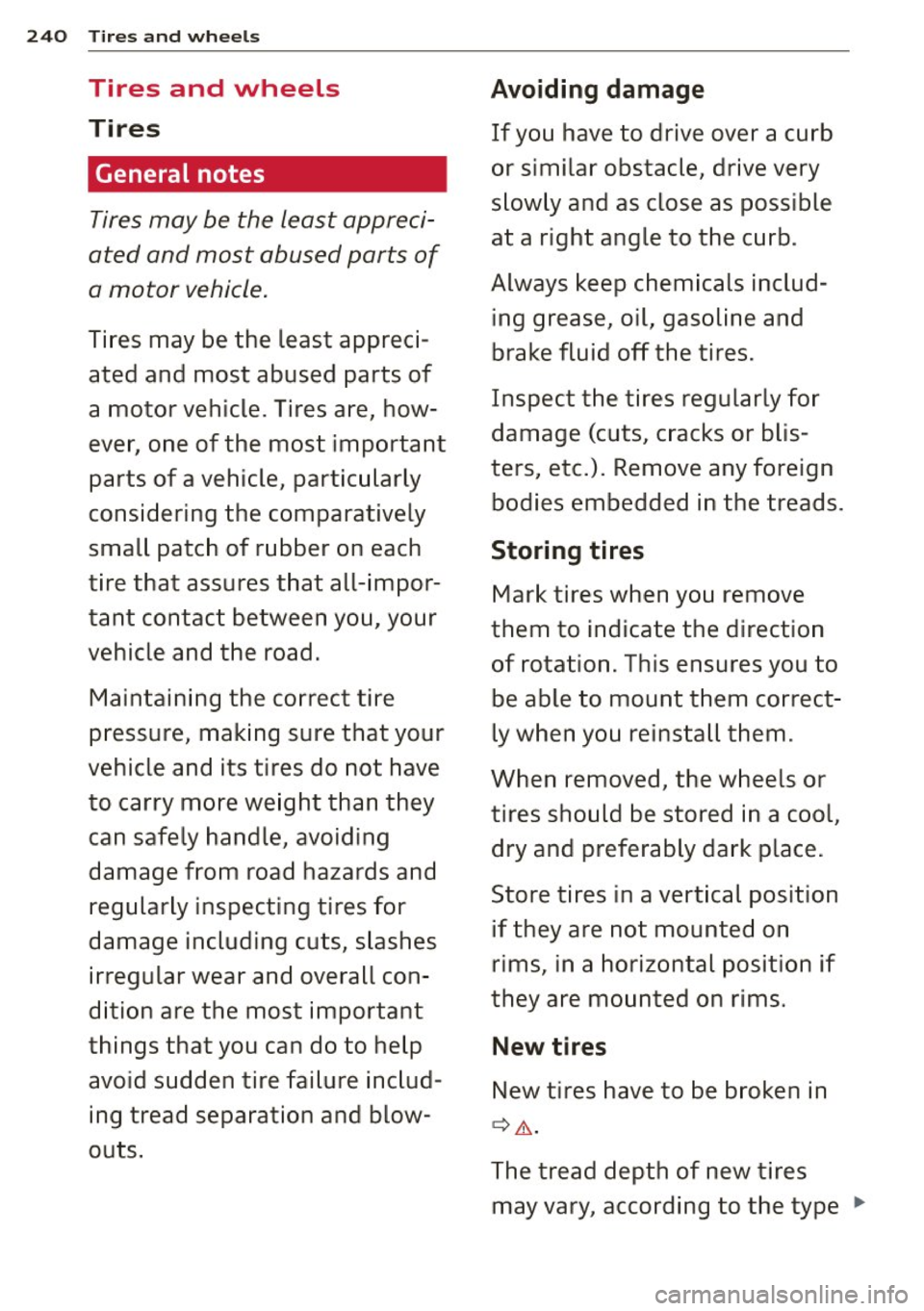
240 Tires and wheels
Tires and wheels
Tires
General notes
Tires may be the least appreci
ated and most abused parts of
a motor vehicle.
Tires may be the least appreci
ated and most abused parts of
a motor vehicle. Tires are, how
ever, one of the most important
parts of a vehicle, particularly
considering the comparatively
small patch of rubber on each
tire that assures that all-impor
tant contact between you, your
vehicle and the road.
Maintaining the correct tire
pressure, making sure that your
vehicle and its tires do not have
to carry more weight than they can safely handle, avoiding
damage from road hazards and
regularly inspecting tires for
damage including cuts, slashes
irregular wear and overall con
dition are the most important
things that you can do to help avoid sudden tire failure includ
ing tread separation and blow
outs.
Avoiding damage
If you have to drive over a curb
or similar obstacle, drive very
slowly and as close as possible
at a right angle to the curb.
Always keep chemicals includ
ing grease, oil, gasoline and
brake fluid off the tires.
Inspect the tires regularly for
damage (cuts, cracks or blis
ters, etc.). Remove any foreign
bodies embedded in the treads.
Storing tires
Mark tires when you remove
them to indicate the direction
of rotation. This ensures you to
be able to mount them correct
ly when you reinstall them.
When removed, the wheels or
tires should be stored in a cool,
dry and preferably dark place.
Store tires in a vertical position if they are not mounted on
rims, in a horizontal position if
they are mounted on rims.
New tires
New tires have to be broken in
¢ &.
The tread depth of new tires
may vary, according to the type .,.
Page 244 of 316
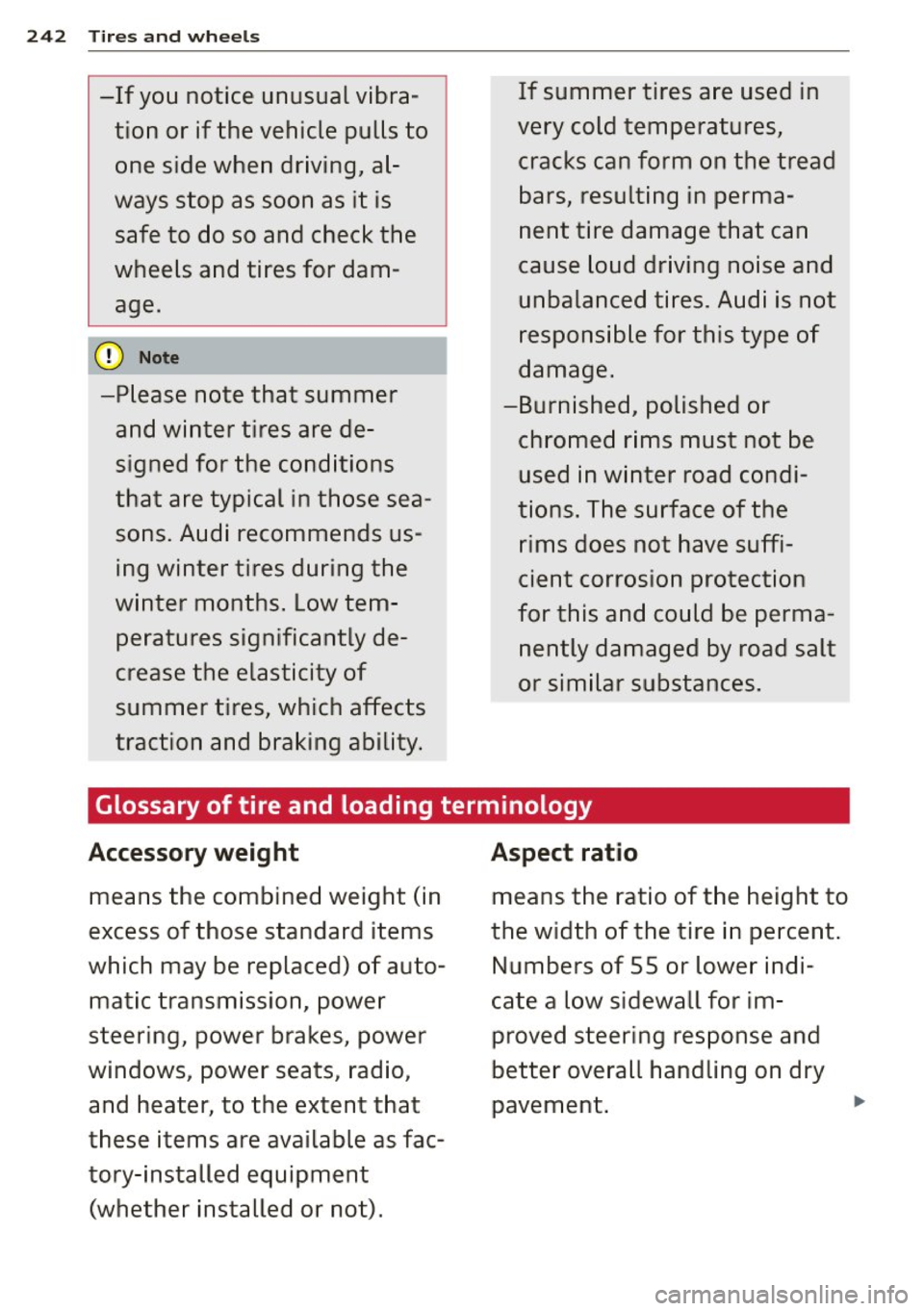
242 Tires and wheels
-If you notice unusual vibra
tion or if the vehicle pulls to
one side when driving, al
ways stop as soon as it is
safe to do so and check the
wheels and tires for dam
age.
0 Note
-Please note that summer and winter tires are de
signed for the conditions
that are typical in those sea
sons. Audi recommends us
ing winter tires during the
winter months. Low tem peratures significantly de
crease the elasticity of
summer tires, which affects
traction and braking ability. If summer tires are used
in
very cold temperatures, cracks can form on the tread
bars, resulting in perma
nent tire damage that can
cause loud driving noise and
unbalanced tires. Audi is not
responsible for this type of
damage.
-Burnished, polished or chromed rims must not be used in winter road condi
tions. The surface of the
rims does not have suffi
cient corrosion protection
for this and could be perma
nently damaged by road salt
or similar substances.
Glossary of tire and loading terminology
Accessory weight
means the combined weight (in
excess of those standard items
which may be replaced) of auto matic transmission, power
steering, power brakes, power
windows, power seats, radio, and heater, to the extent that
these items are available as fac
tory-installed equipment (whether installed or not).
Aspect ratio
means the ratio of the height to
the width of the tire in percent.
Numbers of 55 or lower indi
cate a low sidewall for im
proved steering response and
better overall handling on dry
pavement.
...
Page 245 of 316
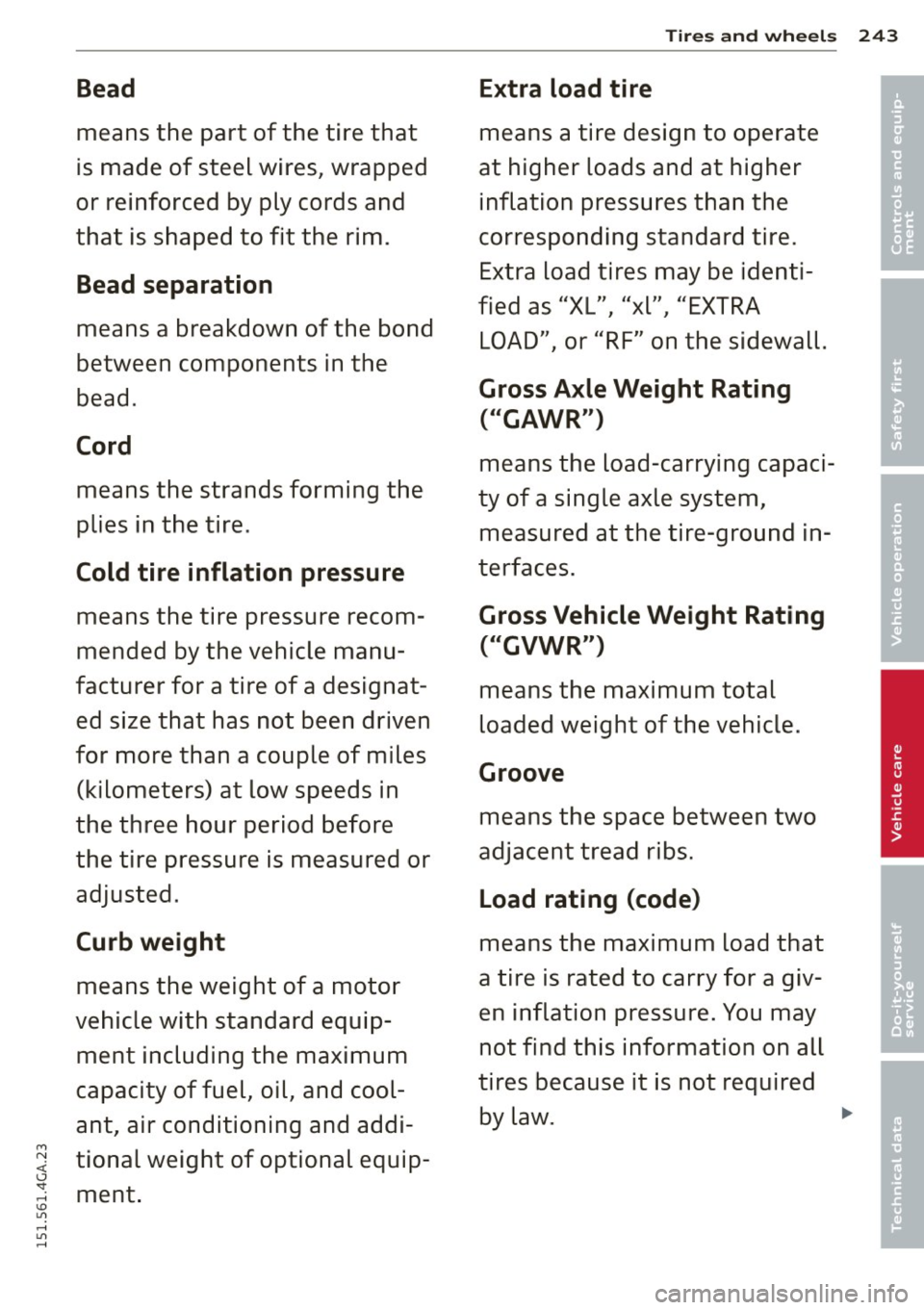
M N <( (.J
'SI: ,...., \!) 1.1'1 ,...., 1.1'1 ,....,
Bead
means the part of the tire that
is made of steel wires, wrapped
or reinforced by ply cords and
that is shaped to fit the rim .
Bead separation
means a breakdown of the bond
between components in the
bead.
Cord
means the strands forming the
plies in the tire.
Cold tire inflation pressure
means the tire pressure recom
mended by the vehicle manu
facturer for a tire of a designat
ed size that has not been driven
for more than a couple of miles (kilometers) at low speeds in
the three hour period before
the tire pressure is measured or
adjusted.
Curb weight
means the weight of a motor
vehicle with standard equip
ment including the maximum
capacity of fuel, oil, and cool
ant, air conditioning and addi
tional weight of optional equip
ment.
Tires and wheels 243
Extra load tire
means a tire design to operate
at higher loads and at higher inflation pressures than the
corresponding standard tire .
Extra load tires may be identi
fied as "XL", "xl", "EXTRA
LOAD", or "RF" on the sidewall.
Gross Axle Weight Rating ("GAWR")
means the load-carrying capaci
ty of a single axle system,
measured at the tire-ground in
terfaces.
Gross Vehicle Weight Rating ("GVWR")
means the maximum total
loaded weight of the vehicle .
Groove
means the space between two
adjacent tread ribs.
Load rating (code)
means the maximum load that
a tire is rated to carry for a giv
en inflation pressure. You may
not find this information on all
tires because it is not required by law.
•
•
'
Page 246 of 316
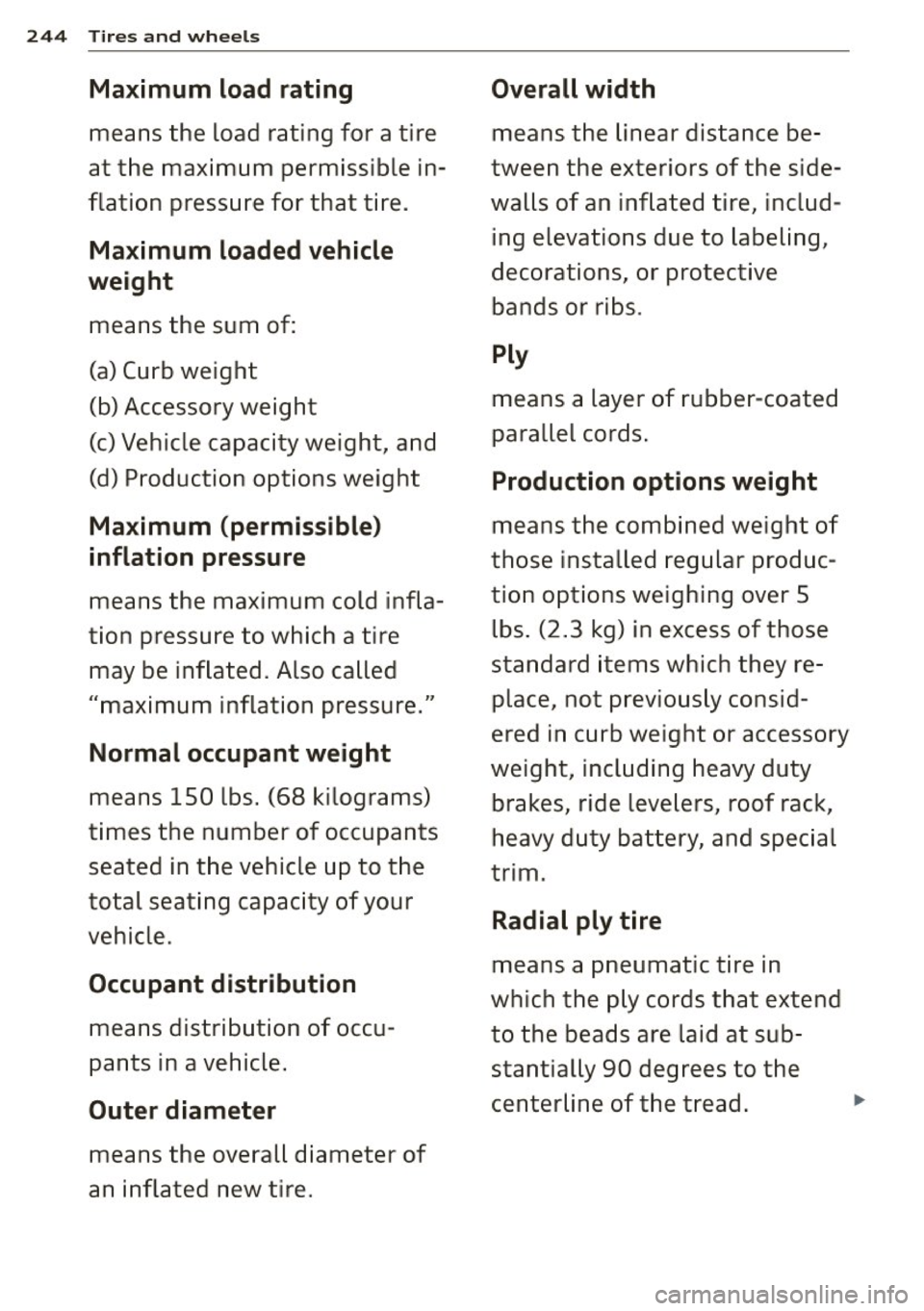
244 Tires and whee ls
Ma ximum load r ating
means the load rating for a tire
at the maximum permissible in
flation pressure for that tire.
Maximum lo ad ed vehicle
weight
means the sum of:
(a) Curb weight
(b) Accessory weight
(c) Vehicle capacity weight, and
(d) Production options weight
Ma ximum (permissible )
inflation pressure
means the maximum cold infla
tion pressure to which a tire
may be inflated. Also called
"maximum inflation pressure."
Normal occupant weight
means 150 lbs. (68 kilograms)
times the number of occupants seated in the vehicle up to the
total seating capac ity of your
vehicle.
Occupant di stribution
means distribution of occu
pants in a vehicle .
Outer diameter
means the overall diameter of
an inflated new tire.
Overall width
means the linear distance be
tween the ex teriors of the side
walls of an inflated tire, includ
ing elevations due to labeling,
decorations, or protective bands or ribs .
Ply
means a layer of rubber -coated
parallel cords .
Production options weight
means the combined we ight of
those installed regular produc
tion options weighing over 5
lbs . (2 .3 kg) in excess of those
standard items which they re
place, no t previously consid
ered in curb weight or accessory
weight, including heavy duty
brakes, ride leve lers, roof rack,
heavy duty bat tery, and special
trim.
Radial ply tire
means a pneumatic tire in
wh ich the p ly cords that extend
to the beads are laid at sub
stantially 90 degrees to the
centerline of the tread .
Page 248 of 316
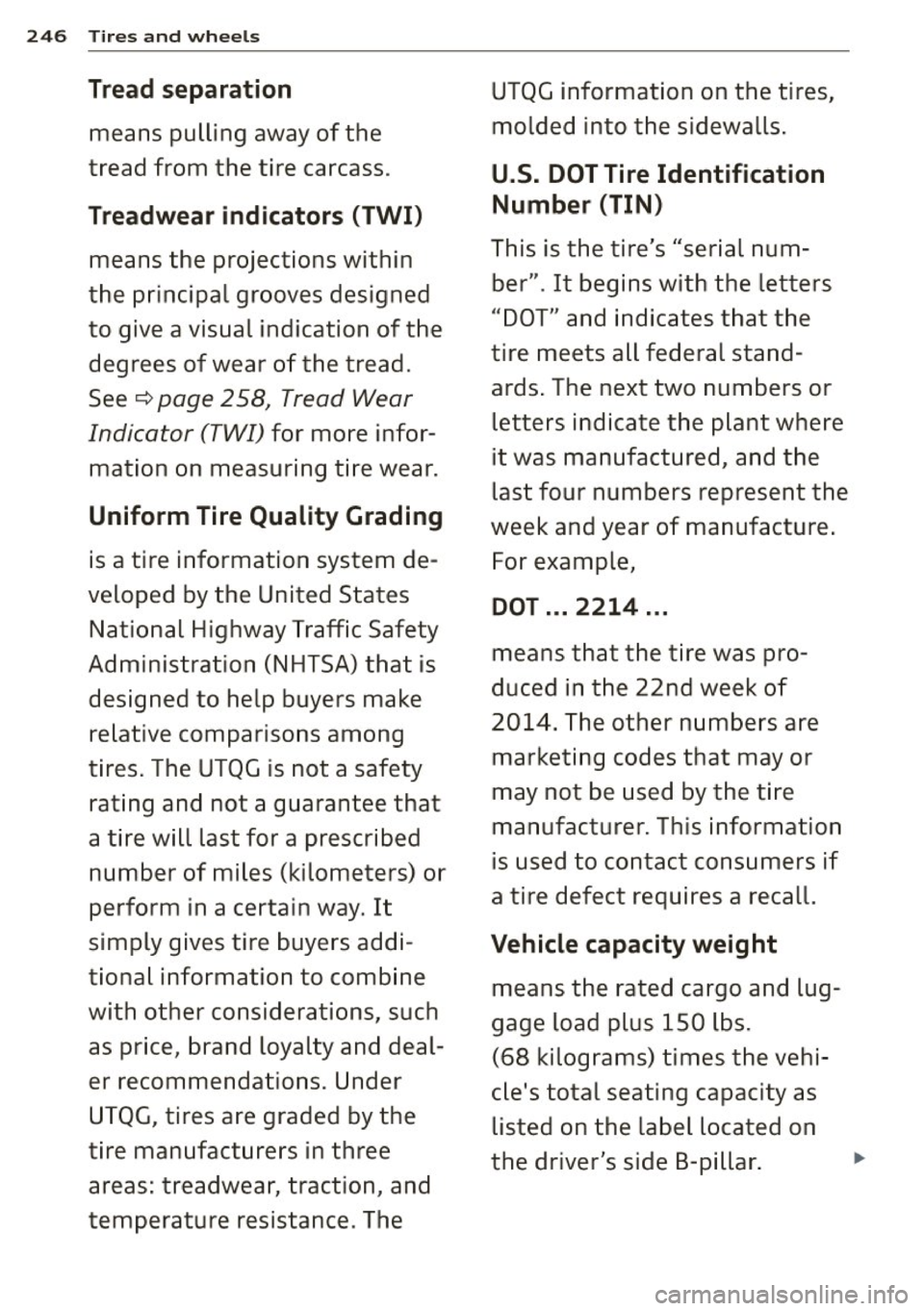
246 Tires and whee ls
Tread sep aration
means pulling away of the
t read from the tire carcass.
Treadwear indicators (TWI )
means the projections within
the principal grooves designed
to give a visual indication of the degrees of wear of the tread.
See
¢ page 2 58, Tread Wear
Indicator (TWI)
for more infor
mation on measuring tire wear.
Uniform Tire Quality Grading
is a tire information sys tem de
veloped by the United States
National Highway Traffic Safety
Administration (NHTSA) that is
designed to help buyers make
relative comparisons among
tires . The UTQG is not a safety
rat ing and not a guarantee that
a tire will last for a prescribed
number of miles (kilometers) or
perform in a certain way. It
simply gives tire buyers addi
tiona l information to comb ine
with other considerations, such as price, brand loyalty and deal
er recommenda tions. Under
U TQG, tires are graded by the
tire manufacturers in three
areas: treadwear, traction , and
temperature resistance . The UTQG information on the t
ires
molded into the sidewalls .
U.S. DOT Tire Identification
Number (TIN)
,
This is the tire's "serial num
ber" . It begins with the letters
"DOT" and indicates that the
tire meets all federal stand
ards . The next two numbers or
letters indicate the p lant where
it was manufactured, and the
last four numbers represent the
week and year of manufac ture.
F or example ,
DOT ... 2214 ...
means that the ti re was pro
duced in the 22nd week of
201 4. T he other n umbers are
marketing codes that may or
may not be used by the tire
manufacturer. This information
is used to contact consumers if
a tire defect requires a recall.
Vehicle capacity weight
means the rated cargo and lug
gage load plus 150 lbs.
(68 kilograms) times the vehi
cle's total seating capacity as
listed on the label located on
the dr iver's side B-pillar . .,..
Page 249 of 316

M N <( I.J "".
Vehicle maximum load on the tire
means that load on an individu
al tire that is determined by
distributing to each axle its
share of the maximum loaded
vehicle weight and dividing by two.
Vehicle normal load on the tire
mean s that load on an individu
al tire that is determined by
Tires and wheels 247
distributing to each axle its
share of the curb weight, acces
sory weight, and normal occu
pant weight (distributed in ac
cordance with table below
¢ page 247) and dividing by
two.
Occupant loading and distribution for vehicle normal load for
various designated seating capacities
Designated seating Vehicle normal load, Occupant distribu-
capacity, number of number of occupants tion in a normally
occupants loaded vehicle
4 2 2 in front
5 3 2 in front, 1 in back
seat
Cold tire inflation pressure
Tire pressure affects the overall handling, performance and safety
of a vehicle.
- Kl'A. . PSI
- KPA. .
PSI
- KPA. . PSI
; Fig. 200 Tire pressure label: located Fig. 201 Tire pressure label
.... l/1 .... on driver's side B-pillar
Page 250 of 316

248 Tires and whee ls
Tire pressure generally refers to tant things you can do to help
the amount of a ir in a tire that avoid sudden tire failure. Un-
it needs it to do its job and derinflated tires are a major
safely carry the combined load cause of sudden tire failure .
of the entire vehicle and its con-
Keeping tires at the right pres-
tents . Tire pressure is measured sure is also important for safe
in kilopascals (kPa), the inter- and responsive vehic le han-
national measuring unit and in dling, traction, braking and
pounds pe r square inch (PSI). load carrying.
Tire pressu res
Ti re pressure is based in part on are particularly important
the vehicle's design and load when the vehicle is being driv-
limit -the greatest amount of en at h igher speeds, and then
weight that the vehicle can car-especially when hea vily loaded
ry safely and the tire size. The even within the permissible
proper tire pressure is frequent-load-carrying capacities ap-
ly referred to as the "recom-proved for your vehicle.
mended cold tire inflation pres-
The recommended tire pres-
sure." Air in the tires expands sures for your Audi depend on
when the tire heats up because the kind of tires on your vehicle
of internal friction when it flex- and the number of passengers
es in use. The ti re pressure is
and/or amount of luggage you
h igher when the tire has
will be transporting.
warmed up than when it is
The tire pressure labe l is locat-
"cold." It is the inflation p res-
ed on the driver's side 8-pillar.
sure in a "cold" tire that counts .
Therefore, you should never let The tire pressure label lists the
recommended cold tire infla-
air out of a warm tire to match
"cold tire inflation pressure" tion pressures for the vehicle at
its maximum capacity weight
recommendations . The tires
would then be underinflated and tires that were on your ve-
and cou ld fai l suddenly . hicle at the time it was manu-
f actured.
...
Maintaining proper tire pres-
sure is one of the most impor-